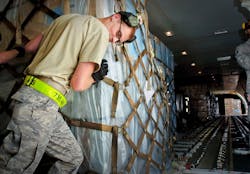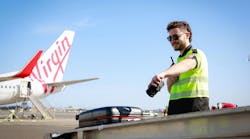July 02--YOKOTA AIR BASE, Japan -- The U.S. military plans to move 35,000 vehicles and 95,000 shipping containers out of Afghanistan as part of the withdrawal of combat forces by 2014, a massive effort that will require large volumes of the cargo to leave the country by way of military and civilian transport planes.
The April crash of a civilian Boeing 747 during takeoff from Bagram Air Base -- blamed on shifting military vehicles inside the plane -- shows how challenging the task will be for those in charge of loading the aircraft for the long trip home.
Crash investigators believe a military vehicle slammed into the back of the cargo space, affecting the center of gravity and causing the nose of the aircraft to rise too quickly. Video footage shows the cargo plane in a steep climb before it plummeted to the ground and exploded, killing all seven crewmembers. According to reports, the aircraft was loaded with three armored vehicles and two mine sweepers -- nearly 80 tons of equipment.
Making sure such heavy, awkward loads are balanced and well-secured is an art and a science, according to some Yokota Air Base airmen who have handled the task in Afghanistan and Iraq during past deployments.
"The way cargo is secured depends on the size of the cargo and also the type of aircraft," said Tech. Sgt. Francisco Vanega, a "port dog" from Yokota's 730th Air Mobility Squadron.
Some cargo is secured to pallets designed to snap securely into each aircraft. Other items are strapped or chained inside the cargo bay, the 38-year-old Valley Head, Ala., native said.
Each aircraft has a center of gravity that the cargo needs to be balanced above, and planners must calculate the best way to arrange the load, Vanega said.
"If you make the plane too nose heavy, it is going to take more runway to get that nose up," he said. "Too tail heavy has the same effect. You want to get the calculation right in the middle."
If the cargo isn't balanced correctly, it can cause problems even while the aircraft is on the ground.
At Yokota the port dogs load up 747s, C-130s, KC-10s, KC-135s and C-17s and a variety of commercial aircraft, the same planes being used to fly cargo out of the war zone.
"We load just about everything you can think of," he said. "If you think of FedEx or UPS -- how they ship boxes and boxes of pretty much everything -- that's basically what we do."
But Afghanistan is a whole new ball game. There's a good chance that load masters will be not be familiar with the cargo, Vanega said.
"You are going to come up with cargo that you have never seen or worked with before," he said. "You have the challenge of safely securing it to the aircraft." The sheer volume of materiel being shipped is also a factor. Each month, hundreds of tons of cargo are being flown out of Afghanistan, including helicopters, armored vehicles, equipment, parts and sustainment supplies no longer needed by redeploying units.
Master Sgt. William Byfield, who returned from Afghanistan in February, said contractors helping with air operations are reducing their presence there, meaning more work for airmen.
"There is a lot of stuff moving," he said, including MRAP All-Terrain Vehicles and Humvees. "Much more is going out than coming in."
Load masters on each aircraft double-check to make sure cargo is secure, said Senior Airman Kyle Cotton, 23, of Fairfax, Va., another member of the 730th who recently returned from Afghanistan.
"If cargo is not tied down correctly it could lead to catastrophic effects," said Cotton.
The country's lack of sea access also is complicating the process.
"It's nothing like we have ever done in the history of our military," said Maj. Gen. Kurt Stein, commander of the 1st Theater Sustainment Command said during a visit to Kuwait in March.
Plans call for much of the gear to be trucked to the Pakistani port of Karachi, then shipped. But massive amounts of equipment still are leaving by air, with plans to fly the equipment to bases in Jordan, Dubai and Oman, where it can be taken to sea ports and sailed back to the U.S.
The U.S. Transportation Command did not directly answer questions about the number of aircraft or Air Force personnel deployed to help with the drawdown.
"We are certainly focusing our efforts and our resources on the task of redeploying 10 years' worth of equipment from Afghanistan, while at the same time continuing to supply the troops and the ongoing efforts there," Transportation Command officials said in an email. "This is a significant task and a challenge that we are working on literally 24 hours-a-day."
One reason for flying heavy vehicles and equipment out of the country instead of driving them out by road is to maintain flexibility and balance strategic reliance among Pakistan, Baltic, Central Asia and Caucasus states, Transportation Command officials said in an email.
The cost of redeploying and retrograding equipment from Afghanistan will cost $5 billion to $7 billion, according to the Department of Defense.
Copyright 2013 - Stars and Stripes





